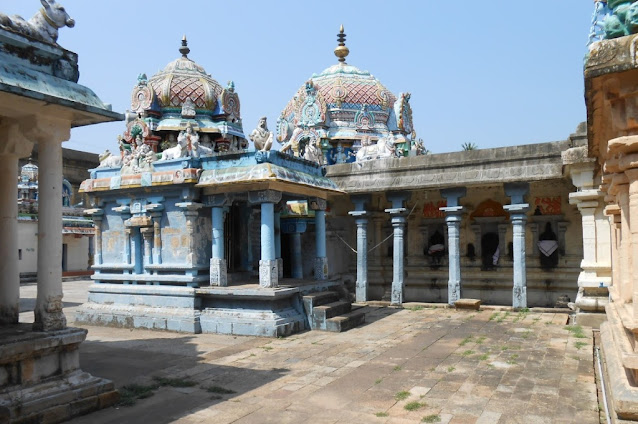Agnipureeswarar Temple,
Thirupugalur – The Temple
This Temple is facing towards east with five tiered Rajagopuram. The entrance to the inner prakaram is crowned with three tiered gopuram. The entire temple complex is surrounded by a moat (Agazhi in Tamil) and one segment of the Agazhi was reclaimed, to gain access to the temple. This moat like tank is called Bana Theertham / Agni Theertham. This temple complex covers an area of about 73,000 sq. feet and has two prakarams.
The Temple is about 325 ft long and 225 ft wide. The entire temple complex is enclosed within the compound wall. Dhwaja Sthambam, Balipeedam and Nandhi can be found in between the Rajagopuram and the inner gopuram. The Sanctum Sanctorum consists of Sanctum, Ardha Mandapam and Maha Mandapam.
Presiding Deity is called as Agnipureeswarar / Agneeswarar / Konappiraan / Saranyapureeswarar / Punnagavana Nathar / Pratyaksha Varadar and is facing east. He is housed in the sanctum in the form of Lingam. Lord is a Swayambhu Moorthy (self-manifested). Lord Shiva graces in the temple as a Swayambumurthi. The Linga is in tilted position confirming the legend related to Banasura.
Vinayaga, Nataraja, Dakshinamoorthy, Agastya, Lingodbhava, Brahma, Durga, Bikshadana and Aalingana Kalyana Sundarar are the koshta idols located around the sanctum walls. Chandikeswarar can be seen in his usual location. Sculptures of Lord Vishnu and Lord Brahma can be seen on either sides of Lingodbhava in the koshta behind the sanctum. Devotees can enjoy the darshan of Hindu trinity (Lord Brahma, Lord Vishnu and Lord Shiva in one place. This darshan is considered to be very auspicious.
Relief of Queen Chembian Maadevi worshiping Lord Shiva can be seen in the outer sanctum wall. Processional Idols (Utsava Idols) of this temple are Agni, Chandrasekarar, Thirupuranthakar and Brahma. The festival image of Chandrasekarar occupies the position reserved for Somaskandar. Utsava Idol of Raamanadeechuram is kept here for safety reasons.
Mother is called as Karundhar Kuzhali / Soolikambal. She is housed in a separate south facing shrine. She is depicted in standing posture. Her shrine is situated immediately after the Rajagopuram. There is a separate shrine for Lord Agni in the Maha Mandapam. Generally, he has no form but in this temple, he appears with two faces, 7 hands, 7 Jwala sparks, four horns and 3 feet. This is a rare Agni Bhagwan idol.
Utsava Idol of Agni is also in the same form. This form of Agni is one of its kinds, not present anywhere in the state. Appar Mandapam is a 100 pillared hall with inscriptions from Kulothunga Chola period. There is a separate shrine for Saneeswarar in this temple. He is gracing the devotees along with Emperor Nala which is not seen in any other temple. Emperor Nala is seen in worshipping posture. Saneeswarar is called as Anugraha Sani as he confers all the wishes of the devotees.
There are three Shiva Lingams in this temple namely Bhoodheshwarar (Kadantha Kaala Nadhar), Vardhamaneswarar (Nikazhkaala Nadhar) and Bhavishyeswarar (Varunkaala Nadhar). These three lingams are believed to symbolize the past, present and the future. This is one of the rare temples representing all the three periods of human life. Hence worshipping in this temple removes the past sins, makes the present life comfortable and ensures mukthi in the future.
There is a separate shrine for Navagrahas in the temple premises. The idols of Navagrahas are not placed in their usual arrangement but are placed in L shaped form. There are several Shiva Lingams found in the temple premises. These Lingams were worshiped by Lord Vishnu, Lord Murugan, Neelakanda Sivachariyar, Indra, Varadarayar and Sages Bharadhwaja, Dadhichi, Vyasa, Brugu, Jamadagni, Pulasthya & Jabali.
There are shrines and idols of Gnana Vinayaga (Sthala Vinayaga) 63 Nayanmars, Panchalinga, Appar, Sundarar, Vatapi Ganapathy, Subramanya with his consorts Valli & Devasena, Sanisvara, Annapoorani, Mahalakshmi, Saraswathi, Kalasamharamoorthy, Chinthamaneeswarar, Nardana Vinayaga, Nataraja, Kasi Visvanathar, Somaskandar, Trimukhasura (three faced asura), Somanayakar with Somanayagi, Bairavar, Vamadeva Lingam and Agora Lingam in the temple premises.
There are paintings in the walls of the temple depicting the legends associated with this temple. Some of the paintings are Lord Shiva turning the bricks to gold bar for Sundarar, Appar throwing precious gems along with the other wastes while doing Uzhavara Pani in this temple, Banasura trying to uproot the Linga for his mother’s worship, darshan of Lord Shiva in the form of Chandrasekara to Agni and celestial nymphs trying to disturb Appar devotion to Lord Shiva.
Sculptures of Kamadhenu worshipping Lord Shiva by pouring her milk over Linga, Nayanmar Appar worshipping Lord Shiva before his Mukthi and Agni worshipping Lord Shiva can be seen in the walls. Theerthams associated with this temple is Agni Theertham / Bana Theertham. The Theertham is in the form of moat (Agazhi in Tamil). There is a stone idol of Chandrasekarar in a mandapam near the Agni Theertham. Sthala Vriksham is Punnai tree. Lord Vishnu is believed to have manifested himself as the Vanni tree here.
























